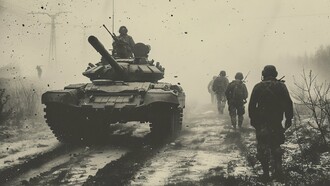The world is witnessing a violent revanchist Russian movement that is a result of a very uncivilized divorce between an independent Ukraine and the Russian Federation after break-up of the Soviet empire in 1991.
This war is taking place in a geopolitical and geo-economic situation in which Moscow perceives that the US, NATO and the EU have all been siding with Kyiv to the exclusion of Russian interests and of the Russophone community in eastern Ukraine.
The war has broken out after the failure of the US and Europeans to engage post-Soviet Russia in a new system of Euro-Atlantic security and after the US and NATO refusal to thoroughly negotiate Russia’s proposed draft treaties, particularly by refusing to address Russian demands for Ukrainian neutrality.
So far Putin’s war goals appear more like those of Bismarck (seeking control over eastern Ukraine from Odessa to Donbass, the Sea of Azov, Kharkiv, to Kyiv) than those of Hitler (expanding to the rest of Ukraine and beyond)—but that could change if Moscow ups the ante by using even more violent and extreme degrees of preclusive imperialism to block military supplies to the Ukrainian resistance from Europe that could result in the real possibility of a major power war.
Signs of a revanchist backlash
The signs of Russian pan-nationalist revanche were evident after the dissolution of the Warsaw Pact in 1989 and German unification within NATO in 1990: The drunken coup attempt against Mikhail Gorbachev in August 1991 and the battle at the Russian White House in 1993. Boris Yeltsin had to make concessions to pan-nationalists who wanted Moscow to protect the Russophone diaspora that remained outside the Russian Federation after the Soviet collapse.
By 1997, the two founders of the US containment policy, George Kennan and Paul Nitze, among many other former US officials, such as Ambassador to Russia, Jack Matlock, had warned President Bill Clinton that the open NATO enlargement would prove to be an error of historic proportions. Nitze had argued that it was far better not to enlarge NATO than to take the risks that the open NATO enlargement would provoke a revanchist Russian backlash.1
During the 1999 NATO air war “over” Kosovo, Yeltsin pleaded with Clinton not to pursue the bombing of Belgrade as the Russian people would “certainly from now on have a bad attitude with regard to America and with NATO.” Not only did NATO opt to go to war without a UN Security Council mandate, but NATO’s “exceptional” war over Kosovo and bombing of Belgrade also violated the 1997 NATO-Russian Founding Act.
Yeltsin then told Clinton that Putin would take his place as acting president in late 1999. In addition to pan-nationalist opposition to his policies of decentralization and neo-liberalism, Yeltsin was replaced by Putin primarily because Yeltsin could not prevent NATO from expanding and bombing Belgrade. NATO's 1999 war over Kosovo then permitted revanchist Russian pan-nationalists to take over the state apparatus under Putin.
The 2003 US-led war in Iraq (which was not a NATO operation) was also fought without a UN Security Council mandate. Putin would use the two wars in Kosovo and Iraq to justify that he, like NATO and the US, could act with violent impunity in Chechnya, Syria and now in Ukraine.
The revanchist backlash begins
In February 2008, prior to the April 2008 Bucharest NATO summit that had promised eventual NATO membership for Ukraine and Georgia, then Ambassador to Russia, William Burns, and now President Joe Biden’s CIA director, had warned:
Not only does Russia perceive encirclement, and efforts to undermine Russia's influence in the region, but it also fears unpredictable and uncontrolled consequences which would seriously affect Russian security interests… Russia is particularly worried that the strong divisions in Ukraine over NATO membership, with much of the ethnic-Russian community against membership, could lead to a major split, involving violence or at worst, civil war. In that eventuality, Russia would have to decide whether to intervene; a decision Russia does not want to have to face.
Note that Burns’ analysis did not state that Russian military intervention in Ukraine was inevitable, but that political circumstances would determine whether Putin would take the path of military intervention. This indicates that U.S. and the Europeans could have at least attempted to engage in preventive-war diplomacy that would have sought to engage in real dialogue with Moscow in the effort to achieve a new system of security in Europe as had been proposed by Moscow in 2008-09.
Yet instead of heeding the warning of Ambassador Burns that NATO enlargement could provoke civil war in Ukraine and possible Russian military intervention, the Bush administration pressed for the eventual NATO enlargement to both Georgia and Ukraine even if potential membership was years away—thereby overruling France and Germany who both opposed NATO expansion at that time.
It was after the uncoordinated US and EU decision in 2008 to continue to expand both NATO and the EU into former Soviet space that Moscow opted for what can be called its first act of preclusive imperialism. After the war was initiated by Tbilisi in South Ossetia, that was intended to gain greater US financial assistance and defense supports, Putin opted to punish Georgia and try to block it from entering both the EU and NATO by backing the independence of South Ossetia and Abkhazia after the US had recognized Kosovo against Serbian interests.
After the overthrow of the kleptocratic leadership of Viktor Yanukovich by the EuroMaiden and Revolution of Dignity movements of 2014, Moscow then feared that it would lose its military base that it had been leasing from Kyiv in Sevastopol if Ukraine joined NATO. Before the EuroMaiden Revolution, Kyiv had been trying to sustain a neutral position between NATO, the EU, and the Russian-led CSTO under the law on Ukraine’s non-aligned status passed in 2010.
Putin then opted to take advantage of the chaos of the protests to support Ukrainian autonomy movements in the Donbass region and engage in an act of preclusive imperialism by annexing Crimea. The U.S., NATO, and the EU categorically refused to recognize the Russian annexation—closing the door to possible diplomacy.
And while Moscow violated the non-binding 1994 Budapest Accord by annexing Crimea, thus violating Ukrainian sovereignty, U.S. promises to bring Ukraine into NATO in 2008 were seen by Moscow as symbolically undermining that Accord in which Ukraine had promised to remain non-nuclear. In effect, the pro-NATO expansion policy undermined the treaty in Russian eyes by promising Ukrainian membership in NATO, thereby linking Ukraine to a “nuclear alliance” as NATO likes to call itself.
The 1994 Budapest Accord was just one of many treaties that began to disintegrate as NATO expanded and as US and Russian relations continued to deteriorate. The ABM treaty, for example, was unilaterally dumped by the U.S. in 2001 so that the Pentagon could deploy Missile Defense systems in eastern Europe and the Far East— ultimately leading Moscow to develop hypersonic weapons in response.
While the Obama administration did pursue negotiations, and tried but failed, to make a deal over Missile Defenses with Putin, the promise of NATO enlargement to Ukraine was still supported by Obama who concurrently initiated the modernization of the U.S. nuclear triad under Congressional pressures despite his promises in Prague in 2009 to seek radical nuclear arms reductions.2
The miscalculated Russia invasion
Now, in 2022, given the fact that no new European Security system had been negotiated since the end of the Cold War, nor as Moscow requested in 2008-09, Putin opted for a brutal and criminal invasion of Ukraine in the effort to preclude the rise of a powerful and potentially hostile state that bordered the Russian heartland and that could be backed militarily by the US and the European Baltic-Black Sea Alliance, if not eventually by NATO, to regain Crimea and other Russian-claimed territories.
While Putin may have expected his invasion to be a “cakewalk” (a term used by neoconservatives in the belief that the Iraqis would not resist the American invasion in 2003), it appears that he significantly miscalculated. The Ukrainian resistance appears fiercer than he expected and the Russophone and Russian Orthodox populations (in Kharkiv and Mariupol, for example) did not appear to have supported his brutal intervention. The Russophone community may favor a more pluricultural Ukraine, which respects Russian language and culture, but they do not necessarily want to live under Putin’s jack boots.
As it so far appears dubious that Putin will try to seize the whole country, even if may have begun to strike military supply routes from Europe into Ukraine, the question remains whether he will try to force a partition by attempting to occupy the eastern and southern regions of the country from Kyiv to the Donbass to Mariupol to the Sea of Azov to Odessa. The question remains: Which territories might he seek to retain (other than Crimea and the separatist republics) and which territories might he consider returning to Ukraine, if he eventually agrees to withdraw forces, possibly to be replaced by international peacekeeping deployments?
The valiant Ukrainian opposition presents the possibility that the Ukrainian people and military can resist Putin much like Finnish people resisted Stalin in the 1939-40 winter war in the effort to sustain their independence—but eventually accepting a formal position of neutrality vis-a-vis Moscow instead of NATO membership.
Four diplomatic dilemmas in wartime
There are at least four diplomatic dilemmas confronting the U.S. and Europeans:
How can the U.S. and European best support the Ukrainian resistance but without leading Moscow to engage in what has been called “Grozny doctrine” of eradicating all urban resistance and killing innocent civilians while concurrently severely repressing antiwar dissent inside Russia itself given close family and cultural ties between many Russians and Ukrainians?
How can the U.S. and European best rachet up strong sanctions on the Russian economy, energy exports, cutting Russian banks out of swift, as well as attempting to place sanctions on Putin himself and upon the super-wealthy oligarchs that support him—but without those sanctions backfiring by destabilizing the global economy through the rise of energy and agricultural prices (wheat and sunflower oil for example) and by increasing the value of the dollar (most likely hurting Europe more than the Americans)?
As Russia turns increasingly to China (and Turkey), how much will these sanctions hurt the general Russian, European and American populations, not to overlook the developing world, as well as American, and primarily European, industries and financial institutions that do business with Moscow, as compared to Putin and Russian elites who lived through even rougher economic times under Yeltsin?How can the U.S. and Europe prevent their support for the Ukrainian resistance from drawing NATO and Russia into direct conflict that could potentially result in a nuclear war? NATO is presently deploying its 40,000-strong Response Force in Poland, Romania, Bulgaria and the three Baltic states, as a deterrent versus a possible Russian attack on its members. NATO’s Article 4 consultations permit it to support and supply Ukraine with arms—actions that could provoke Moscow as could possible accidents and third-party actions. The Ukrainian proposal to establish a no-fly zone inside Ukraine, for example, has thus far been rightly opposed by NATO.
How can the U.S. and European best engage in diplomacy that withdraws NATO membership for Ukraine in the establishment of a “neutral” or “non-aligned” state, while attempting to negotiate disputes over the Crimea and the separatist movements in the Donbass, plus removing the Russian troop presence—but without appearing to totally capitulate to Putin?
Hope to defeat Putin
One can hope that social protest in Russia could stop Putin. One can also hope for a coup d’etat backed by the military or Russian oligarchs, whose vast wealth along with the Russian economy appears to be declining due to U.S. and EU sanctions.
Yet as Putin closes down independent and social media, and violently represses dissent, it appears unlikely that social revolution in Russia will be able to alter Putin’s march. And Putin can always blame the war on anti-Russian leadership in the U.S. and Europe in an effort to gain popular support for his revanchist cause. Nor does it appear likely that a Russian Brutus will be in a position the slay the new Russian Caesar with his many body guards and systems of security any time soon.
Nevertheless, the more the Ukrainians can resist (in part with the help of drones, anti-aircraft and anti-tank weapons supplied by the U.S. and NATO members including Turkey), the more Putin will have second thoughts about occupying the country, ultimately forcing Moscow to withdraw its forces.
Relentless diplomacy
It is possible that Turkey (which is playing a double game between the U.S. and Russia), China (which most stands to benefit from Russian isolation), Israel, India (as well as Pope Francis) could help calm Putin’s temper and arrange for humanitarian corridors or even a ceasefire, for example.
Yet these states cannot address the crucial questions of NATO and of European security. So this leaves NATO and EU member France, tacitly backed by the US, to become the primary mediator, much as was the case after the 2008 Georgia-Russia war.
The political goals of Putin’s brutal and criminal invasion and his potential occupation of an already truncated Ukraine are to break the ties between Ukraine and NATO and to gain Ukrainian and international recognition for the Russian annexation of Crimea and for the independence of the separatist People’s Republics in the Donbass region after the refusal of Kyiv to fully implement the Minsk II agreements.
The dilemma is that the negotiating process could ultimately result in an unjust peace in which Kyiv will need to give up its demands to enter NATO. At the same time, however, given the hatred on both sides generated by this conflict, such peace in Ukraine could represent a temporary truce before the beginning of a new phase of conflict that could extend beyond Ukraine to other areas of the former Soviet empire if a revanchist Russia continues to plot new attacks—and particularly if no new system of European security can eventually be negotiated.
While the task will evidently not prove easy, what Biden himself has called “relentless diplomacy” is needed to eventually forge a new European security order—as had been urged by Moscow prior to its invasion. A European new treaty could be eventually forged around a neutral and non-nuclear Ukraine that could then seek to negotiate its disputes over the Donbass and Crimea with Russia, in addition to the disputes over Russian language laws.3
Given the reticence of Biden and NATO to bring Ukraine into NATO, a truly neutral Ukraine, with its disputed borders protected by international peacekeepers under a general OSCE mandate, for example, and with a limited defensive capability, would be closer to achieving the neutral position that Kyiv originally demanded when it declared independence in 1991.
Given the strong Ukrainian resistance, the withdrawal of Russian military forces in exchange for the deployment of international peacekeepers may help minimize charges of capitulation to Putin. A state can be neutral and remain democratic, as has been the case for Finland, Sweden and Austria.
It is crucial that the US and Europe better coordinate their strategy and engage in truly relentless diplomacy that will avert the real possibility that the ongoing war over Ukraine could soon provoke an even more dangerous and expansive conflict. In revising the words of Cicero: It is far better to negotiate an unjust peace in Ukraine and seek to implement a new European Security treaty with Moscow—than risk the real possibility of a Global and Nuclear War.
Patriarch’s ponds
Homage to Mikhail Bulgakov’s The Master and Margarita:
In the icy park
across from Patriarch’s Ponds
Berlioz and Bezdomny debate
the atheistic aesthetics
of a Jee-Zus!!! Poem
when from out of the bowels
of a tool shed steps forward
Woland dressed
as the park superintendent...Sitting on a nearby bench
and offering to share
“Our Brand” cigarettes
he interrupts their dispute
with his critique of Kant’s proof
of God’s existence
lecturing with the air
of a neophyte Prof…But alas! He can’t convince
these two sceptical souls
that Jee-Zus!!! actually existed…
despite his desperate efforts
to detail the dastardly deeds
of Pontius Pilate against
the prisoner crucified
for wanting to tear down
the walls of temples…For if he could prove
that Jee-Zus!!! really existed
then these two cold intellos
with no imagination
whatsoever would know
that the Devil did too!Dismayed that the two eggheads
now think he’s a lunatic, if not a spy,
Woland turns and stares
at two cowboys who just happen
to strut across the park
sporting white ten-gallon hats…
Their Colt six-shooters with pearl handles
glisten triumphally in the silvery light…“You will see!” Woland cries out,
clenching his fist in rage:
“You will see! We will rise again!”
Yes! We will rise again!”(Moscow, 2005)
Notes
1 Hall Gardner, Dangerous Crossroads (Praeger, 1994).
2 Hall Gardner, NATO Expansion and US Strategy in Asia (Palgrave, 2013).
3 Hall Gardner, Crimea, Global Rivalry, and the Vengeance of History (Palgrave 2017).















